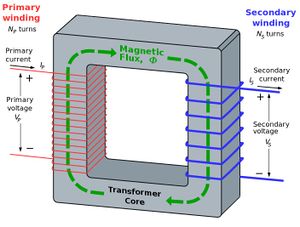Transformer
 From Conservapedia
From Conservapedia 

A transformer is a device that transfers electrical energy from one circuit to another, usually at different voltages.
Early electrical systems were developed using direct current. However, the heat loss limited the ability to send electric power a long distance from the generating station. This caused the industry to adopt alternating current. With alternating current, electric power is generated at a low voltage. A "step up transformer" then raises the voltage to a much higher level (for example 220,000 volts). Power can travel down a transmission line at a high voltage with less energy being converted to heat.[1] When the electric power arrives at a local substation a "step down transformer" will lower the voltage. Finally, at a point near an individual customer's house, a final transformer will lower the voltage to 120 volts (in the United States) or 230 volts (in Europe).
Contents
- 1 Operation
- 2 Threats
- 3 See also
- 4 Bibliography
- 5 External links
- 6 References
Operation[edit]
A transformer works because the two circuits are wound around a common magnetized metal core. As the current alternates on the first circuit, it creates a varying magnetic field. That field, in turn, induces a current in the coils of the second circuit. The ratio of the voltage on the two circuits is determined by the ratio of the number of times coils on the two circuits are wrapped around the metal core that serves as a magnet.
Threats[edit]
Newt Gingrich and other conservatives have expressed concerns about the viability of power grid transformers against threats from modern adversaries such as Islamic jihad terrorists, China, Russia and North Korea. They consider the current "hardening" of transformers to be a major issue requiring investment.[2]
If there is a major disaster, damaged transformers may have to be replaced, and both homeland security experts as well as the electric utilities are worried that the inventory and placement of spare transformers may not allow the electric grid to be reenergized quickly. As a result, the industry is attempting to arrange for nationwide cooperation in the distribution of spare transformers and parts to respond to such emergencies.
See also[edit]
- Rectifier - Converts alternating current into direct current
- Inverter - Converts direct current into alternating current
Bibliography[edit]
Harlow, James (2004). Electric Power Transformer Engineering. CRC Press. ISBN 0-8493-1704-5.
External links[edit]
- Three-phase transformer circuits from All About Circuits
- Inside Transformers, composed by J. B. Calvert, from Denver University
- Introduction to Current Transformers
References[edit]
- ↑ Joule heating equal i2R. If the voltage doubles, the current is cut in half to transmit the same power. This will cut the heat loss by 1/4.
- ↑ One Second After written by William Forstchen with a forward by Newt Gingrich discusses this potentially major threat to modern power transformers: Amazon.com, Tor Books, 2011. Accessed January 5, 2015.
Categories: [Electronics] [Energy] [Electricity] [Radio] [Electricity]
↧ Download as ZWI file | Last modified: 02/23/2023 02:09:08 | 43 views
☰ Source: https://www.conservapedia.com/Transformer | License: CC BY-SA 3.0
 ZWI signed:
ZWI signed: KSF
KSF